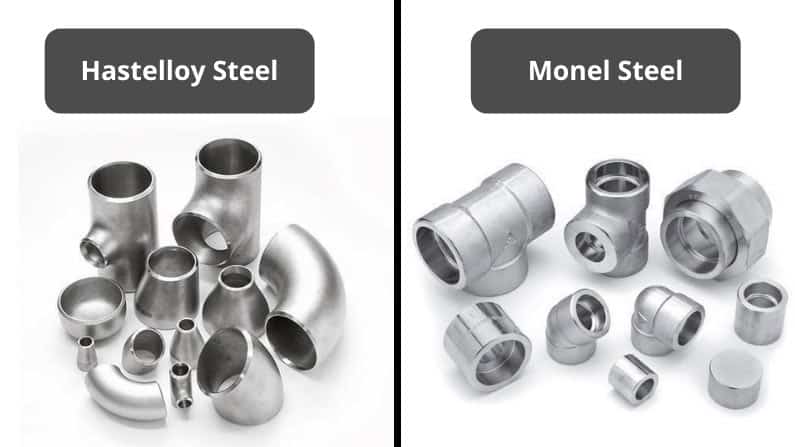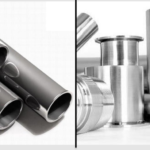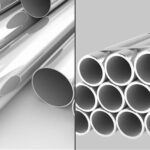Hastelloy and Monel are two different alloys.
Monel is a malleable, corrosion-resistant metal that is stronger than steel. This alloy group possesses good resistance to extremely corrosive acids, such as hydrofluoric and sulfuric acid, in addition to superior resistance. Monel is particularly well suited to maritime engineering applications due to its increased copper content. Monel components function well in brine solutions because of the copper presence, which provides some resistance against biofouling. Hastelloy, on the other hand, is resistant to acidic solutions. Solutions of sulfuric acid, nitric acid, hydrochloric acid, hydrofluoric acid, and chromic acid are among the corrosive acids. The resistance of these alloys to sulfuric acid, in particular, is a significant addition to processing-based businesses, as just a few alloys are resistant to this acid. The alloy’s remarkable resistance to stress-related corrosion cracking is another important feature. Because of the high nickel concentration, the material could be employed at high temperatures. Hastelloy’s resistance to oxidative corrosion is enhanced by the inclusion of chromium, which also makes these alloys resistant to uniform and localized corrosion.
The price difference between Hastelloy and Monel alloys
Unlike Hastelloy, which has numerous other components in its chemical makeup, most monel alloys have a nickel content of 60 to 70%. Nickel’s worth as a metal is thought to be high because its cost is variable and the metal is a commodity. Hastelloy has less nickel in its chemistry than monel, making monel the more expensive metal in contrast to the former.
Hastelloy and monel contain nickel.
Although both Hastelloy and monel alloys contain nickel, the amount of nickel added in their composition differs. While monel alloys comprise roughly 30% to 40% copper, the nickel percentage varies between 60% and 70%, depending on the monel grade made. Hastelloy contains substantial amounts of metals such as ferrous or iron, chromium, molybdenum, cobalt, and tungsten, but the remaining nickel is added to the alloys for which it is intended. As a result, some Hastelloy has lower content than monel.
How do you determine the difference between Hastelloy and Monel?
While metals have a lot in common in terms of appearance, obtaining a mill test report or a material test report is one of the most effective ways to distinguish between them. In most circumstances, manufacturers can obtain an MTR or a mill test report for the buyer as a measure of ensuring the product’s quality. A material test report, in general, is a complete test report on the material’s elemental makeup as well as its mechanical or physical qualities.
The melting point of Hastelloy and Monel
Several alloys, unlike pure metals, do not have a single melting point. However, these alloys do have a melting range or a melting point. The substance or alloy is a mixture of solid and liquid phases throughout this temperature range. Slush is the term for this mixture of phases. Most Monel alloys have a melting point of roughly 2460 degrees Fahrenheit. Hastelloy grades have a somewhat higher melting point, around 2550 degrees Fahrenheit.
Hastelloy and Monel are strong metals.
The stress that metal, or in this case, alloys, can withstand without permanent deformation or a limit at which the material will refuse to return to its original dimensions, which is around 0.2 percent of its length, is calculated as yield strength. The yield strength of various Hastelloy grades at 0.2 percent offset ranges from 310 Mpa to 355 Mpa. In contrast, the yield strength of Monel alloys with a 0.2 percent Offset can range from 240 Mpa to almost 790 Mpa.
Ultimate tensile strength of Monel and Hastelloy
Unlike yield strength, which is computed with a 0.2 percent offset, tensile strength is the greatest stress that an alloy can withstand when being stretched or pulled before failing or breaking. Monel alloys have tensile strengths ranging from 550 MPa to around 1100 MPa. In comparison to monel, the tensile strength of numerous Hastelloy grades ranges from roughly 690 Mpa to about 783 Mpa.
Monel equivalent grade
| ALLOY | WERKSTOFF NR. (WNR) | UNS | AFNOR | GOST | BS | JIS | EN |
| Monel 400 | 2.4360 | N04400 | NU-30M | МНЖМц 28-2,5-1,5 | NA 13 | NW 4400 | NiCu30Fe |
| Monel 404 | 2.4867 | N04404 | |||||
| Monel 405 | N04404 | ||||||
| Monel K500 | 2.4375 | N05500 |
Monel chemical compatibility chart
| ALLOY | ASTM/ AISI | UNS | %AL | %CU | %MN | %NI | %TI | %FE | %SI |
| Monel 400 | B 127, B 164 | N04400 | 28-34 | 2.0 max | 63 min | 2.5 max | 0.5 max | ||
| Monel 401 | N04401 | 28-34 | 2.0 max | 63 min | 2.5 max | ||||
| Monel 404 | N04404 | 0.05 max | Rem | 0.1 max | 52-57 | 0.5 max | 0.1 max | ||
| Monel K-500 | B 865 | N05500 | 2.3-3.15 | 27-33 | 1.5 max | 63 min | 0.35-0.85 | 2.0 max | 0.5 max |
| Monel 405 | B 164 | N04405 | 28-34 | 2.0 max | 63 min | 2.5 max | 0.5 max |
Monel yield and tensile strength
| ALLOY | TENSILE STRENGTH | YIELD STRENGTH (0.2%OFFSET) | DENSITY | MELTING POINT | ELONGATION |
| Monel 400 | Psi – 80000, MPa – 550 | Psi – 35000, MPa – 240 | 8.8 g/cm3 | 1350 °C (2460 °F) | 40 % |
| Monel 404 | 70 KSI min (483 MPA min) | 25 KSI min (172 MPA min) | 8.91 gm/cm3 | 1300 – 1350℃ | 35 % |
| Monel 405 | 550 Mpa | 240 Mpa | 8.80 g/cm3 | 1300 – 1350°C | 40 % |
| Monel K500 | Psi – 160000, MPa – 1100 | Psi – 115000, MPa – 790 | 8.44 g/cm3 | 1350 °C (2460 °F) | 20 % |
Hastelloy material grades
- HASTELLOY B2 ®
- HASTELLOY C ®
- HASTELLOY C276 ®
- HASTELLOY N ®
- HASTELLOY S ®
- HASTELLOY W ®
- HASTELLOY X ®
Hastelloy equivalent
| STANDARD | WERKSTOFF NR. | UNS | GOST | AFNOR | JIS | OR | EN |
| Hastelloy C22 | 2.4602 | N06022 | – | – | NW 6022 | – | NiCr21Mo14W |
| Hastelloy C276 | 2.4819 | N10276 | ХН65МВУ | – | NW 0276 | ЭП760 | NiMo16Cr15W |
| Hastelloy B2 | 2.4617 | N10665 | |||||
| Hastelloy B3 | 2.4600 | N10675 | |||||
| Hastelloy C4 | 2.4610 | N06455 | |||||
| Hastelloy C-22HS | – | N07022 | |||||
| Hastelloy C2000 | 2.4675 | N06200 | |||||
| Hastelloy Hybrid BC1 | 2.4708 | N10362 | |||||
| Hastelloy X | 2.4665 | N06002 |
Hastelloy mechanical properties
| DENSITY | MELTING POINT | TENSILE STRENGTH | YIELD STRENGTH (0.2%OFFSET) | ELONGATION | |
| C22 | 8.69 g/cm3 | 1399 °C (2550 °F) | Psi – 1,00,000 , MPa – 690 | Psi – 45000 , MPa – 310 | 45 % |
| C276 | 8.89 g/cm33 | 1370 °C (2500 °F) | Psi – 1,15,000 , MPa – 790 | Psi – 52,000 , MPa – 355 | 40% |
| B2 | 9.2 g/cm3 | 1370 °C (2550 °F) | Psi – 1,15,000 , MPa –760 | Psi – 52,000 , MPa – 350 | 40% |
| B3 | 9.2 g/cm3 | 1370 °C (2550 °F) | Psi – 1,15,000 , MPa –760 | Psi – 52,000 , MPa – 350 | 40% |
| C4 | 8.64 g/cm3 | 1350-1400 °C | 783 | 365 | 55% |
| Hybrid BC1 | 8.83 g/cm³ | 1343 – 1443°C | 725 | 310 | 40% |
| X | 8.22 g/cm³ | 1355°C | 655 MPa | 240 MPa | 35% |
Hastelloy chemical compatibility
| Material / Purity (%): | C-276 | C-22 |
| Ni | 57.0 | 56.0 |
| Co | 2.50 | 2.50 |
| Cr | 15.5 | 22.0 |
| Mo | 16.0 | 13.0 |
| W | 4.00 | 3.00 |
| Fe | 5.50 | 3.00 |
| Si | 0.080 | 0.080 |
| Mn | 1.000 | 0.500 |
| P | 0.025 | 0.010 |
| S | 0.010 | 0.020 |
| V | 0.350 | 0.350 |



